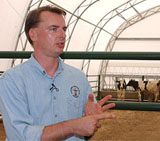Research: Stream Bank Biodiversity Benefits Farmers

By Sylvia Wright, UC Davis News Service
 | |
| UC Davis researcher Shannon Sokolow, left, and graduate student Anna Young-Mathews sample soil beside a stream on a Yolo County farm. (Louise Jackson/UC Davis photo) |
On farms and rangelands in Yolo County, Calif., the stream and canal areas with the greatest variety of plants and soil organisms have the healthiest soil and least pollution potential, according to a novel UC Davis study.
“We inventoried plants and soil organisms on a large landscape level and matched them to indicators of ecosystem health," said one of the study authors, UC Davis ecologist Louise Jackson.
"This is really a milestone for cattlemen and growers managing their lands. They need to know that increasing the number and type of plants on their stream banks is associated with improved environmental quality."
The UC Davis research team included Jackson, a professor and Cooperative Extension specialist in the Department of Land, Air and Water Resources, and holder of the Orr Endowed Chair in the Environmental Plant Sciences; graduate student Anna Young-Mathews; postdoctoral researcher Steven Culman; geographer Allan Hollander; nematologist Howard Ferris; and soil scientist Toby O’Geen.
In the spring of 2007, on 40,000 acres in California where people graze cattle and raise wheat, walnuts, corn, tomatoes, oats and barley, the researchers used geographic tools to divide the landscape into sampling units. In representative sites, they counted plants and soil organisms; surveyed pesticide and fertilizer use, tilling practices and stream-bank disturbances; and measured the amount of nutrients (nitrate and phosphate) and carbon in the soil.
They found the fewest beneficial soil nematodes and microbes in the most intensively managed agricultural lands and on their adjacent stream banks. These lands also had less soil carbon, so had less potential to counteract global warming. Finally, the most intensively managed lands had excess nutrients, which can run off and pollute waterways.
In contrast, on farms and ranches where the landowners had maintained natural riparian zones, or had restored them by planting shrubs and trees along the waterways, the soil had more carbon and less pollution potential. The most biodiverse riparian zones provided the highest levels of these "ecosystem services."
The study results are published in the journals Agroforestry Systems (September) and Landscape Ecology (November). The study was funded by the Kearney Foundation of Soil Science.







